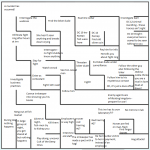FormerlyHemlock
Hero
I found this useful and want to recommend it: http://www.jamisbuck.org/presentations/rubyconf2011/#title-page
It has some thought-provoking observations on mazes which are obviously relevant to any game designer or DM creating a dungeon or other maze in his game.
Naturally, as a DM, you don't have to construct all of the "walls" out of stone. A monster can be a "wall" which seals off a portion of the maze, too, and so can a clue. And as a DM you don't necessarily need to restrict yourself to perfect mazes--in fact you might deliberately seek out an imperfect maze so that the players have multiple routes to victory.
It's worth a read.
It has some thought-provoking observations on mazes which are obviously relevant to any game designer or DM creating a dungeon or other maze in his game.
Naturally, as a DM, you don't have to construct all of the "walls" out of stone. A monster can be a "wall" which seals off a portion of the maze, too, and so can a clue. And as a DM you don't necessarily need to restrict yourself to perfect mazes--in fact you might deliberately seek out an imperfect maze so that the players have multiple routes to victory.
It's worth a read.
Last edited:

